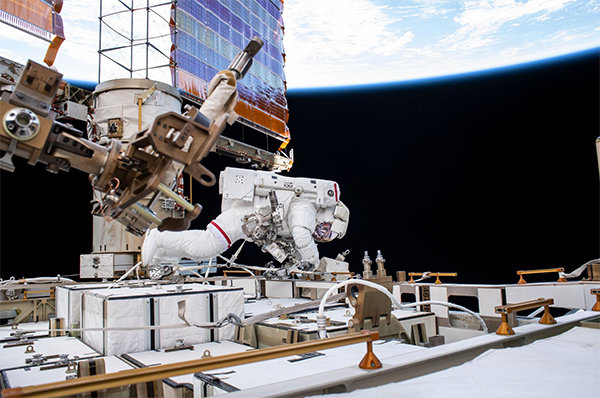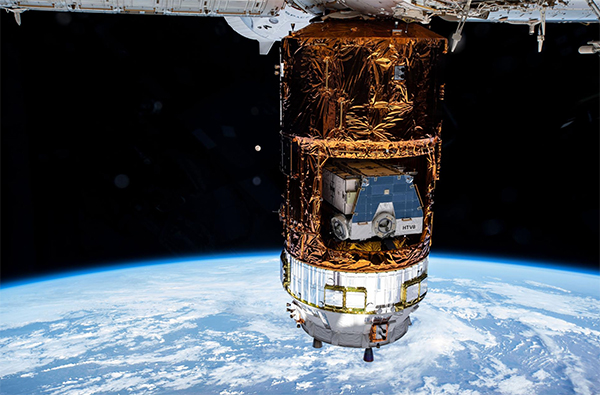Spacewalkers Complete Multi-Year Effort to Upgrade International Space Station Batteries
By Space Coast Daily // February 3, 2021
ISSn orbits Earth at about 17,500 miles per hour

(NASA) – Changing batteries may sound like a menial task, but in space, it requires careful planning.
Eight years of research and development and 14 spacewalks to replace aging batteries are part of an overall electrical system upgrade to help us continue research after 20 years of continuous human presence aboard the International Space Station.
As the International Space Station orbits Earth at about 17,500 miles per hour, it passes between sunlight and darkness every 45 minutes.
During the 45 minutes that the space station is in sunlight, its solar arrays provide power to the station and gather power to be stored in the batteries on the station’s truss structure.
Once the station crosses the “terminator line,” or the difference between day and night on Earth, the station’s batteries provide stored power to be routed throughout the space station. This electricity powers everything from the station’s life support systems to the vacuums the crew uses to keep the station clean – and everything in between.

Upgrades to the International Space Station are designed to maximize the capability of the orbiting laboratory to support scientific research and technology development. The station is also open for business, and serves as a base to continue the development of a robust commercial economy in low-Earth orbit. In addition, the work being done to maintain the station and conduct research are helping prepare NASA for future long-duration missions to the Moon with Artemis, and eventually, to Mars.
The space station’s primary power system originally used nickel-hydrogen batteries for storage. In 2009, the International Space Station Program conducted a preliminary risk and feasibility study to evaluate the use of lithium-ion batteries to replace the power storage system.
In early 2011, the program approved development of the new battery. Production started in late 2014, and in December 2016, NASA began the process of replacing the aging batteries with new lithium-ion batteries.
After four flights of the Japanese H-II Transfer Vehicle (HTV) cargo spacecraft and 13 different astronauts conducting 14 spacewalks, the primary power system has now been fully upgraded to lithium-ion technology.
The new batteries were provided by Boeing, who also worked with Aerojet Rocketdyne and others for certain components.
The space-grade lithium-ion cells were provided by GS Yuasa Lithium Power. One lithium-ion battery and corresponding adapter plate replaces two nickel-hydrogen batteries. Adapter plates, manufactured by Atec, provided heat to the lithium-ion batteries while on the Japan Aerospace Exploration Agency (JAXA) HTV Exposed Pallet until they were transferred to the station’s truss for installation.

This feature is no longer necessary once the batteries are installed, as each lithium-ion battery contains two internal heaters per cell that provide thermal conditioning after activation. Once installed, the adapter plates complete the electric circuit between the lithium-ion batteries and the Battery Charge/Discharge Units (BCDUs) to allow the transmission of power, telemetry, and commands.
The BCDUs are critical to using the power stored in the batteries. These route part of the solar power gathered by the arrays from the primary power bus to charge the batteries. When in sunlight, part of the power gathered by the solar arrays operates the station, while the other part is stored in the batteries. When in darkness, the BCDUs direct energy from the batteries back onto the primary power bus to be used by the station.
The first delivery of six lithium-ion batteries and adapter plates arrived aboard JAXA’s HTV-6 mission in December 2016, and the final set launched on May 20, 2020, aboard JAXA’s HTV-9 mission, the last launch of the first-generation HTV spacecraft.
Ground controllers were able to use the space station’s robotic Canadarm2 to position batteries for installation for the solar arrays nearest the center of the station’s backbone, but the far sets of solar arrays were out of the robotic arm’s reach, requiring additional spacewalkers for each set.
Teams did run into some challenges along the way.
A failure within one of the BCDUs during activation opened the downstream fuse in one of the new batteries in April 2019, requiring robotic operations to replace the BCDU and to re-install two nickel-hydrogen batteries until a replacement lithium-ion battery could be delivered to the space station in January 2020 aboard the SpaceX Dragon on its 19th commercial resupply services mission.
In addition, a second failed BCDU on the outboard truss required an additional spacewalk to replace it – that was the first all-female spacewalk with NASA astronauts Christina Koch and Jessica Meir.
While some nickel-hydrogen batteries are disconnected and stored permanently on adapter plates outside of the station, many were reattached to the HTV spacecraft’s Exposed Pallet and disposed of upon HTV’s re-entry into Earth’s atmosphere.
In its final configuration, the space station now has three lithium-ion batteries for each channel, each with a service life lasting nearly 10 years. With eight channels, 24 lithium-ion batteries on board replaced 48 nickel-hydrogen batteries. The greater energy density of lithium-ion technology reduces the number of needed batteries (and launch vehicles), translating into fewer cargo manifest spots required for the batteries.
NASA-sponsored research on lithium-ion batteries may result in improved safety for their use on Earth. When a cell in a lithium-ion battery overheats, the battery can experience a self-sustaining thermal event known as thermal runaway.
The space station lithium-ion batteries make use of a radiant barrier shield, first developed for rocket engines, to reduce the likelihood of a thermal runaway event. Through NASA’s Technology Transfer program, California-based company KULR Technology developed more accurate ways to test for these issues and developed a Thermal Runaway Shield (TRS), which removes heat from lithium-ion cells, saves weight and reduces battery size over traditional designs. The TRS, developed for spacesuit lithium-ion battery packs, can be used in a variety of ways, from satellites and spacecraft to electric bikes and scooters.
Eventually, the TRS could be used in electric cars, drones, and planes.
With battery upgrades aboard the space station complete, the focus turns to solar array augmentation. Over the next several years, six new solar arrays will arrive at the International Space Station aboard three SpaceX cargo spacecraft. Though functioning well, the original arrays are beginning to reach the end of their 15-year lifespans.
New arrays will be installed on future spacewalks and supply the station with more than 20 kilowatts of power each. The remaining uncovered solar array pair and the partially shadowed legacy arrays remaining in place beneath the new arrays will continue to generate approximately 95 kilowatts of power for a total of up to 215 kilowatts (215,000 watts) of power available to support station operations at completion.
Battery Deliveries and Associated Spacewalks
Near Starboard Truss (S4)
Batteries delivered on HTV-6, launched Dec. 2016
Jan. 6, 2017: Spacewalk with Shane Kimbrough and Peggy Whitson
Jan. 13, 2017: Spacewalk with Shane Kimbrough and Thomas Pesquet (ESA)
Near Port Truss (P4)
Batteries delivered on HTV-7, launched Sept. 2018
March 22, 2019: Spacewalk with Nick Hague and Anne McClain
March 29, 2019: Spacewalk with Nick Hague and Christina Koch
April 8, 2019: Spacewalk with Anne McClain and David St. Jacques to prepare for future work
Far Port Truss (P6)
Batteries delivered on HTV-8, launched Sept. 2019
Oct. 6, 2019: Spacewalk with Christina Koch and Andrew Morgan
Oct. 11, 2019: Spacewalk with Christina Koch and Andrew Morgan
Oct. 18, 2019: Spacewalk with Christina Koch and Jessica Meir to replace failed BCDU
Jan. 15, 2020: Spacewalk with Christina Koch and Jessica Meir
Jan. 20, 2020: Spacewalk with Christina Koch and Jessica Meir
Far Starboard Truss (S6)
Batteries delivered on HTV-9, launched May 20, 2020
June 26, 2020: Spacewalk with Chris Cassidy and Robert Behnken
July 1, 2020: Spacewalk with Chris Cassidy and Robert Behnken
July 16, 2020: Spacewalk with Robert Behnken and Chris Cassidy
Feb. 1, 2021: Spacewalk with Mike Hopkins and Victor Glover












